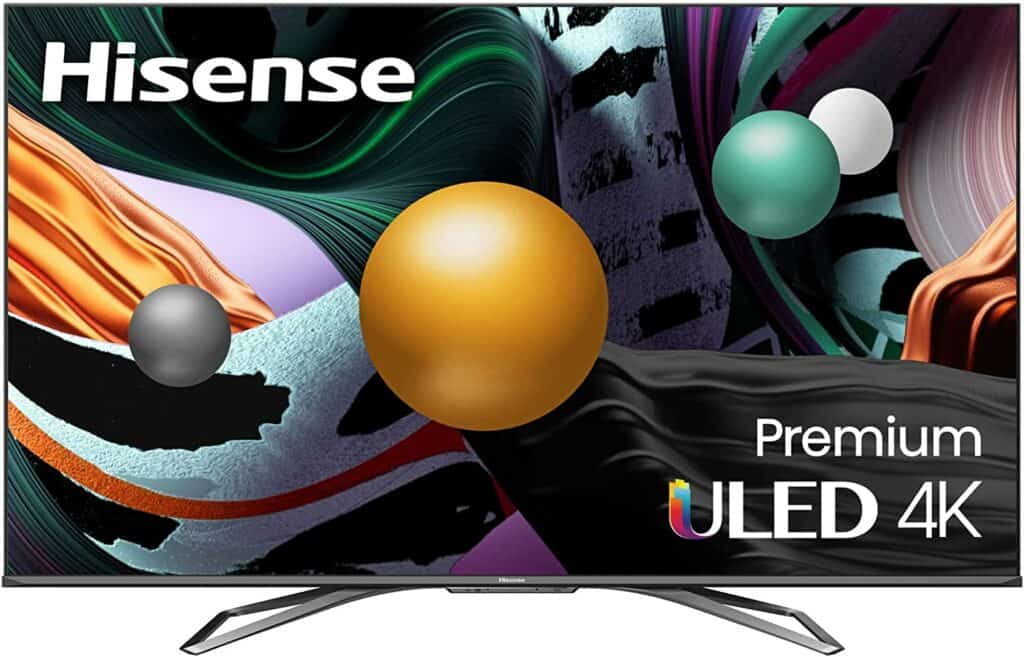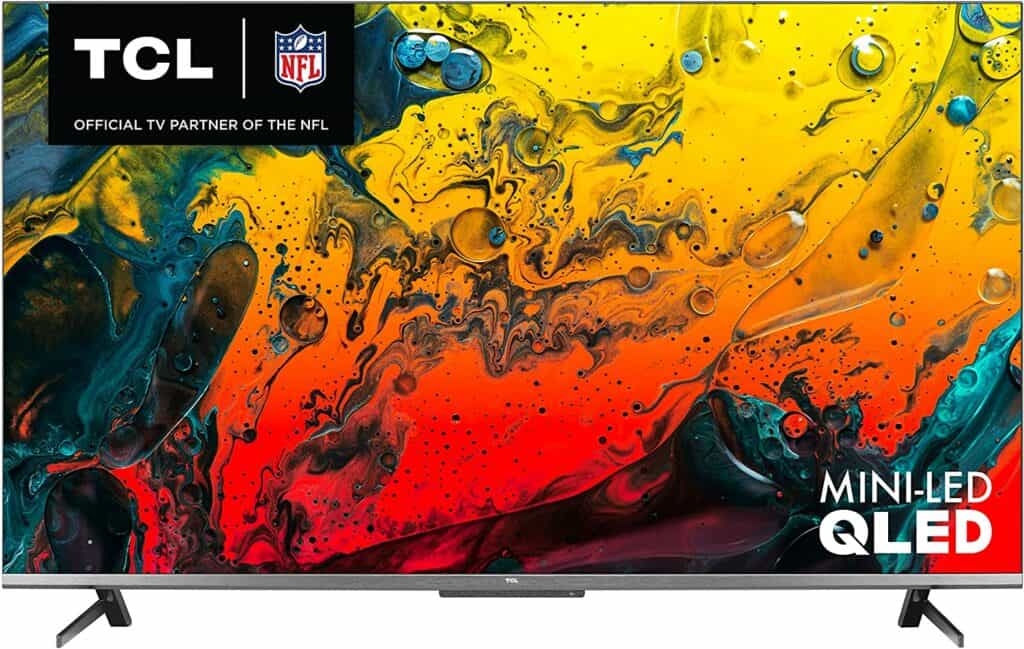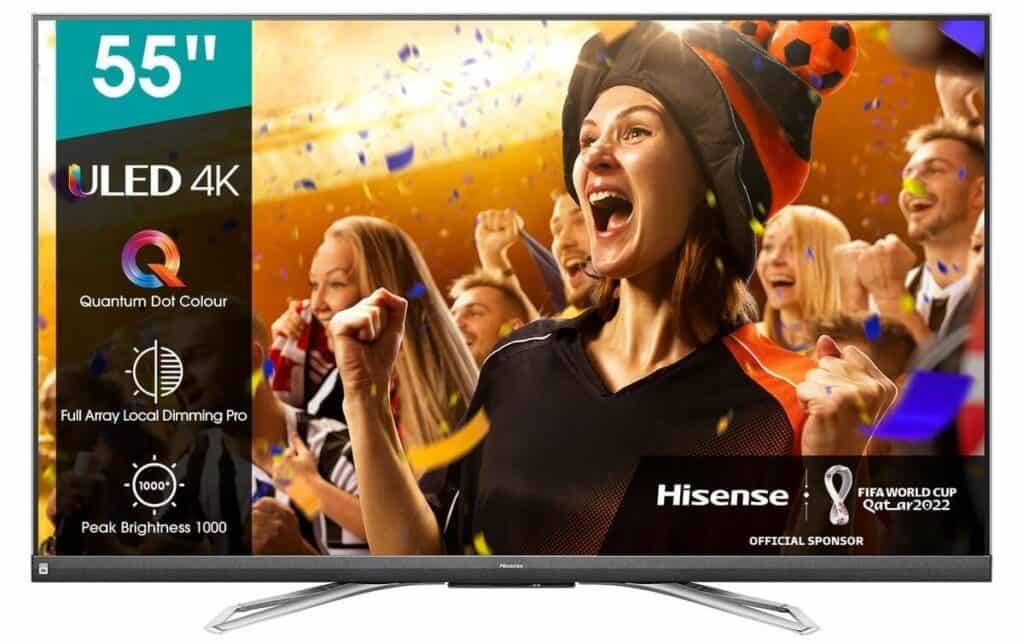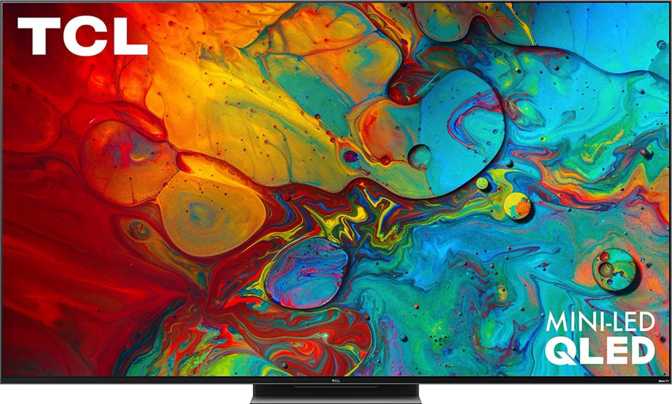That’s almost it. You’re down to the last two choices before deciding which TV to buy. It’s between Hisense U8G vs TCL 6 Series. Both are excellent LED TVs, each with their advantages and reasons to buy.
Now let’s take a look at which has more advantages in this side-by-side comparison.
Hisense U8G vs TCL 6 Series – Overview
| Features | Hisense U8G | TCL 6 Series |
|---|---|---|
| Screen Sizes | 55 and 65 inches | 55, 65 and 75 inches |
| Screen Panel | QLED | QLED |
| Processor | ARM Cortex | AIPQ Engine |
| Operating System | Android TV 10 | Google TV / Roku TV |
| Refresh Rate | 120 Hz | 120 Hz |
| Variable Refresh Rate (VRR) | Yes | Yes |
| Resolution | 4K | 4K |
| HDMI Ports | 4 | 4 |
| USB Ports | 2 | 2 |
| Wi-Fi and Bluetooth | Yes | Yes |
| Speakers | 20 Watts (2.0 channels) | 15 Watts (2.0 Channels) |
| Price | Check Price on Amazon | Check Price on Amazon |
We had the opportunity to compare these two TV brands in our TCL vs Hisense TVs comparison article, and they were tied at the end.
Of course, that was just a broad overview of the two brands, but what about these two models — U8G vs 6 Series?
Here are the quick pros and cons for both:
Hisense U8G

Pros:
- Excellent peak brightness
- Solid reflection handling
- Very good contrast
- 120Hz VA
- Full Array Local Dimming
Cons:
- Narrow viewing angles
- Lacks bass
TCL 6 Series

Pros:
- Excellent peak brightness (~1200 nits)
- Solid reflection handling
- Very good contrast
- Includes Dolby Atmos and Dolby Vision
- Two HDMI 2.1 ports
Cons:
- Narrow viewing angles
- Black smearing on fast-moving content
Features Face to Face
Panel Technology
When it comes to panel technology, both TVs are using QLED displays with VA panels. Unfortunately, this means that both of them have pretty mediocre viewing angles like all Vertical Alignment panels.
Winner: Draw
Image Processor
Like the other Hisense TVs, Hisense U8G uses an ARM Cortex processor. More specifically, you get four cores — 2x ARM Cortex-A73 and 2x ARM Cortex-A52 — under the hood.
TCL 6 series, on the other hand, is armed with the AiPQ Engine processor, which provides a great 4K HDR experience, clear colors and high contrast.
These are both solid CPUs in their own right, but the machine learning algorithm that TCL’s AiPQ Engine processors include gives it an edge here, especially when it comes to optimizing non-4K content.
Winner: TCL 6 Series
Motion Technology
Both TVs deserve high grades for motion technology; however, the Hisense U8G is just a little better here with 9.3ms 100% response time vs TCL 6 Series 11.1ms.
Of course, both TVs are plagued with certain problems, namely visible black smearing with fast-moving objects on the screen, but that is a common VA problem.
In addition, both TVs support Variable Refresh Rate (VRR), though the feature is not available in Game Mode on U8G, and on the 6 series, the Low Framerate Compensation (LFC) doesn’t work very well.
Winner: Hisense U8G
Picture Quality
Contrast Ratio / Black Level
When it comes to the contrast ratio, both TVs offer deep contrast between blacks and whites.
Hisense took a step forward compared to the previous H8G model and it offers a contrast ratio of 54,000: 1 and is able to deliver deep blacks.
On the other hand, TCL 6 Series has a solid contrast ratio, but at 40,000: 1, it sits just below the Hisense TV’s specs. Where it beats it, however, is with the higher native contrast of 8,000: 1.
Winner: Draw
Local Dimming
Both models include Full Array Local Dimming. Here, the Hisense model has 132 zones, while TCL’s has 128 zones, so there’s no noticeable difference.
Winner: Draw
Peak Brightness
While both TVs deliver impressive peak brightness, Hisense is better here, with 1600 nits compared to TCL’s 1200 nits.
On SDR content, however, the 6 Series offers fantastic brightness at around 800 nits, while U8G isn’t as bright at 562 nits.
Where Hisense gets one over is the HDR content brightness with, for instance, peak 25% window brightness of 1,500 nits versus 1,000 nits on the 6 Series.
Winner: Hisense U8G
Color
The color on the Hisense U8G is a little better, with this model having a DCI P3 xy coverage of 97.42% and DCI P3 uv of 97.12%, and the 1,000 nits DCI P3 coverage of 84.6%.
The 6 Series also has a solid color with a color gamut of 91.53% DCI P3 xy and 96.50% DCI P3 uv and around 75% 1,000 nits DCI P3 coverage, but it’s still slightly below U8G.
Winner: Hisense U8G
Viewing Angles
Like most VA panels, these two TVs also have poor viewing angles.
Here, we’re talking about around 25 degrees before you start noticing color washout on both models.
On the Hisense TV, you’ll have a little more room before brightness loss —around 35 degrees — compared to TCL’s 30 degrees. The color stays better on TCL until a few degrees over 30, while on U8G, you’ll see a color shift already at 25 degrees.
Winner: Draw
Reflections / Anti-Glare
Both TVs handle reflections well, thanks to semi-gloss screen finishes.
The U8G is slightly better here, with 2.3% total reflection, against the 6 Series with 3.1%, while indirect reflections are around 0.5% for both models.
Winner: Hisense U8G
Sound Quality
The Hisense U8G model has two audio channels with 20 Watts output per channel, while the TLC also has 2.0 audio channels, but with 15 Watts output per channel. Hisense gets the edge here.
That said, TCL 6 Series handles distortion much better, even at higher or max volume, where there’s hardly any.
Winner: TCL 6 Series
Smart TV Platform (Operating System)
Hisense U8G saw an upgrade from the Android 9.0 OS that the previous models were using, to Android 10.
The TCL 6 Series uses Roku TV and Google TV OS.
While Android TV and Google TV are pretty much the same thing, just with different names, Roku TV has a lot more channels (around 2,000) compared to Android TV (around 600), but only 4GB max storage capacity compared to the Android TV’s 8GB.
That said, both offer smooth user experience and lots of apps, so it’s really a matter of preference.
Winner: Draw
Connectivity
Inputs
There’s not a ton of difference when looking at inputs.
Both TVs support most resolutions — including 1080p@60Hz, 1080p@120Hz, 4K@60Hz and 4K@120Hz.
Here are the input lags you can expect:
| Resolution | Hisense U8G | TCL 6 Series |
|---|---|---|
| 1080p@60Hz | 15.2 ms | 14.2 ms |
| 1080p@120Hz | 5.9 ms | 5.8 ms |
| 4K@60Hz | 15.2 ms | 14.4 ms |
| 4K@120Hz | 5.8 ms | 5.8 ms |
Speaking of total inputs, these TVs come with the following:
- Four HDMI ports each
- Two USB ports each
- One Digital Optical Audio Out, 3.5mm Analog Audio Out, Ethernet and Tuner (Cable/Ant) port each
Winner: Draw
Voice Assistants
These two TVs both have Google Assistant integrated and are Amazon Alexa-compatible.
Winner: Draw
Wireless Technologies
Both TVs support WiFi 2.4 GHz and 5 GHz as well as Bluetooth 5.0.
Winner: Draw
Price
We couldn’t find either of these TV’s in stock on Amazon, but we included links above, just in case they come back in stock. The Hisense U8G was replaced last year by the newer U8H, which is much easier to find on Amazon.
Price-wise, both TVs are in the $700 to $1000 range for the 55-inch models.
Winner: Draw
Conclusion
In the end, these two TVs are pretty well matched and the choice comes down to personal preferences.

We recommend getting the Hisense U8G if you want:
- Better response times
- Higher peak brightness overall
- Better reflection handling

On the other side, TCL 6 Series is the better choice if you’re looking for:
- Better sound quality
- Higher peak brightness in SDR
- A more powerful CPU
Go ahead and let us know if you agree or disagree with our Hisense U8G vs TCL 6 Series comparison in the comments below.